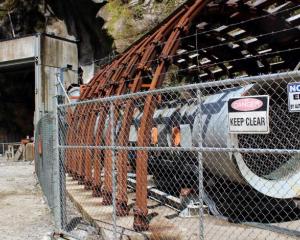If they survive, they will need to be prepared to wait for a long time for help to come.
Geologist Dr Simon Cox, of GNS Sciences, Dunedin, presented a frightening scenario to more than 50 people at a seminar in Haast on Wednesday night, held as part of the Department of Conservation's summer programme.
His seminar updated residents and visitors on earthquake research developments before going on to describe the rich and varied geology of the area caused by the alpine fault.
Haast is home to 297 permanent residents, according to Census 2006 data, and can have up to 700 visitors a day.
The population lives right on top of the faultline in a 50km stretch of small coastal villages between the Haast River and Jackson Bay.
The faultline starts hundreds of kilometres up the coast and continues down to the Jackson River, through the Cascade Valley to Milford Sound.
An earthquake of magnitude 7 or 8 could devastate large parts of the South Island, Dr Cox said.
Haast residents could expect to lose at least their power supply and hydro scheme.
They might also have to head for the hills to avoid coastal tsunamis.
Large rock landslips would block the alpine highways providing access out of Haast.
Rivers would also be dammed, creating the potential for dam-burst floods of sediment down the river valleys - presenting another threat to residents as they fled the coast.
Intense shaking of the ground could also cause "sand volcanoes" - where sand liquefies - that would "burst out everywhere", Dr Cox said.
Scientists from New Zealand and overseas have studied the alpine fault and collected data showing major ruptures occurred at Haast about 1430, 1620 and 1717.
In 1717, the Haast River channel was offset by at least 8m.
They have also discovered the rate of movement between the Australian and Pacific plates - which creates the fault line - is 35mm a year.
Scientists thought the alpine fault was sliding along quietly but after analysing tests on soil age, they realised a grand shake was more likely.
Scientists have been warning of the destructive impact a large rupture would have on the South Island population and environment.
"The current thinking [is] that the 8m shift will happen in one motion.
That could be a reasonably small earthquake, believe it or not, to get 8m.
But the nasty piece of information is there's an 8m shift up here [at Maruia, in Canterbury] as well, at the same age [about 1717] . . .
If it is the same earthquake, then that was one of the world's greatest earthquakes," Dr Cox said.
After the seminar, Haast civil defence spokesman and Westland district councillor Kerry Eggeling said that while large loss of life may not occur because of the small population, the people who lived along the fault line would have to rely on their own resources for some time.
Most West Coasters kept well-stocked pantries because of the distance from markets.
Many also grew vegetables and could hunt or fish.
"We might be without power for a long time but I think we would cope with that," he said.
The potential for tsunamis was a concern because the settlements were so close to the sea.
People had few options other than head up the river valleys, he said.












